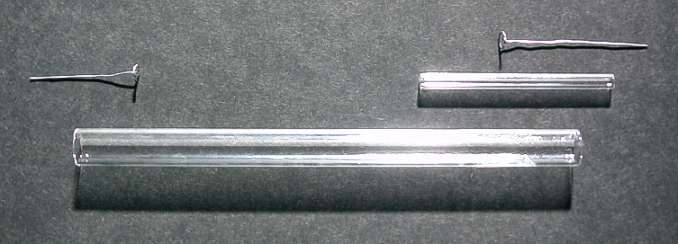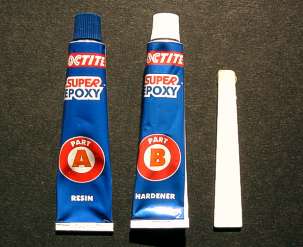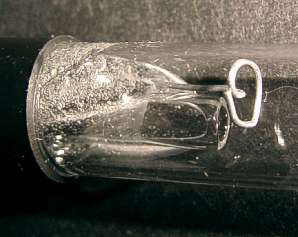

| Page 1 | Experiments Menu | Teralab Main Menu | Page 3 |
|---|
In the Glass Blowing section, a glow tube is described which consists of a completely sealed glass envelope with glass to metal seals. It is difficult to make and interest has been expressed in plans for a similar device which is much easier to construct.
This tube requires very little glass working skill. The only glass work required, is to cut off a 160mm length of 8mm OD glass tube and smooth the end. A 65mm length of 5mm OD glass tube is also required. Information about Cutting Tubes can be found in the Glass Blowing section.
The only other parts required are the electrodes. I used aluminium wire, because it has a low sputtering rate. Sputtering is where high speed ions in the plasma, knock atoms from the electrode causing it to be deposited on the glass. Copper wire will do instead and is easier to solder to. The required parts are shown below.

 For the assembly, I used
Loctite Super Epoxy adhesive. This epoxy resin is clear and sets very rapidly. Araldite Rapid
would work just as well.
For the assembly, I used
Loctite Super Epoxy adhesive. This epoxy resin is clear and sets very rapidly. Araldite Rapid
would work just as well.
The 5mm tube becomes the pump stem. It is important not to block it with adhesive. It is
also important not to cover the end of the electrode. The epoxy adhesive must fill
the space between the outside of the 5mm tube and the inside of the 8mm tube completely
so that it is air tight.
 This is the assembly after
the adhesive has set.To keep the parts in place, I stuck them to a piece of card using
Blu-Tack. The epoxy was then forced in using the plastic spatula.
This is the assembly after
the adhesive has set.To keep the parts in place, I stuck them to a piece of card using
Blu-Tack. The epoxy was then forced in using the plastic spatula.
A length of instrument wire was attached to the electrode using special solder suitable
for aluminium. Ordinary solder can be used if the electrodes are copper. More epoxy was
then applied to protect the joint. To tidy up the end of the tube, heat shrink tubing
was applied.

A similar procedure was used for the other end of the tube, except for the absence of the 5mm pump tube. The red wire has high voltage insulation for connection to the voltage supply. The white wire connects to earth.

Below, the tube has been connected to a rotary pump via the hose on the right. The electrodes are connected to a high voltage power supply. The current is limited by the high output resistance of the power supply.

As the tube is not sealed, it can be used to experiment with different gas fillings. Below is a table of the different colours which can be expected.
| Gas or Vapor | Glow Colour |
|---|---|
| Hydrogen | Blue/violet |
| Helium | Pale salmon pink |
| Nitrogen | Pink/white |
| Oxygen | Blue/violet |
| Carbon dioxide | Blue/white |
| Neon | Red |
| Argon | Violet |
| Krypton | Lavender |
| Xenon | Blue |
| Water vapor | Pink |
On page 3 a system for gas filling is described.
| Page 1 | Experiments Menu | Teralab Main Menu | Page 3 |
|---|